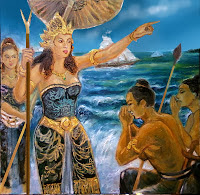IJO TEMPLE - to Honour the Greatness of BHATARA SHIVA
OM SWASTI ASTU
Ijo Temple is a complex of Hindu Temples, 4 km south-east of Ratu Boko Temple, or about 18 km east of Yogyakarta City. It is located exactly at the top of Gumuk Ijo, the highest point in the Shiva Highlands in Prambanan area, about 375 - 410 metres above sea level. That's why this temple is called Candi Ijo or Ijo Temple. The name "ijo" in Javanese Language means "green".
Ijo Temple is a complex of Hindu Temples, 4 km south-east of Ratu Boko Temple, or about 18 km east of Yogyakarta City. It is located exactly at the top of Gumuk Ijo, the highest point in the Shiva Highlands in Prambanan area, about 375 - 410 metres above sea level. That's why this temple is called Candi Ijo or Ijo Temple. The name "ijo" in Javanese Language means "green".
From this highest point, we could see fantastic natural panorama such as trees, grasses, rice-fields, and hills. Farther away, we could see the beauty of Adisucipto Airport of Yogyakarta.
Ijo Temple is situated at Dukuh Groyokan, Desa Sambirejo, Prambanan Sub-Regency, Sleman Regency, Special Territory of Yogyakarta (Daerah Istimewa Yogyakarta). Within 8.000 metres square area, the temple stand tightly, strong, and always ready to overcome everything. In the wide area of the temple, there are so many artefacts found by surrounding people, and also found by Balai Kepurbakalaan Jawa Tengah - DIY.
The name "Candi Ijo" in old Javanese Language had been already mentioned in the Poh Pitu Inscription (906 AD) in the sentences : "...... anak wanua, i wuang ijo....." means : "...... a village child, a citizen of Ijo.....". Poh Pitu Inscription was issued at the era of King (Sri Maharaja) Rakai Watukura Dyah Balitung, a famous Hindu king of Medang i Bhumi Mataram Kingdom. He ruled after about 5 generations after Rakai Pikatan Pu Manuku. As we know, Rakai Pikatan Pu Manuku married a princess of Medang i Bhumi Sambhara, named Pramodhawardhani, the daughter of Rakai Garung or Samarottungga.
The main temple stands at the uppermost terrace. It consists of a large temple facing the west,with a large Lingga and Yoni inside it, and there are three perwara temples in front of the main temple, facing the east.
Entirely, the temple consists of 17 temples, constructed in 11 terraces. The terraces stands along with three ancilary temples. Only the eleventh terrace has been restored completely. The others are still in reconstruction projects.
The main temple is dedicated to worship Lord Shiva (Mahadev) and the other temples are to worship Lord Brahma and Lord Visnu. Lord Brahma, Visnu, and Shiva are aspects of The Almighty GOD in Hinduism - ADI BRAHMAN. Whether the main or the perwara temple, each has a room inside it. The roof of all the temples arranged in three stages, adorned with rows of ratnas. The reliefs carved along the temple wall indicates that Ijo Temple is dedicated to worship Trimurti. Motif of Makara heads are carved at the top of each temple-gate. The motif of makara heads remind us not to Hindu temples in Prambanan area, but also Buddhist Temples, such as Borobudur, Pawon, Mendut, and Ngawen, near Magelang City.
Lingga and Yoni of the main temple of Ijo Temple is the largest Lingga and Yoni in Indonesia. It is the symbol of Lord Shiva and Parvati, overviews the nature of man and woman in the fertility, as the beginning of life. A stone phalles shaped round cylinder stands above the Yoni-shape niche with a tip, as the flow line of water. The flow line symbolizes the flow of Gangga River holy water. In Hindu religion it mentions that the holy water comes out of Lord Shiva.
Beside Lingga and Yoni, we also could see the beauty of Nandi statue, inside a temple. And there are reliefs of flying man and woman figure. It is the symbol of Lord Shiva and Parvati, when they expel the evil spirit.
There are two inscriptions found at the temple area. The first is one metre tall and the other is 14 cm height and 9 cm thickness. The small one contains 16 repeated spells and one of them says " Om sarwwawinasa, sarwwawinasa.".
It is very important for us, to visit the ancient temple. Not like other temples in Java Island, Ijo Temple means more misterious. Besides, the temple is located at the place named Shiva-Highlands.
May the power of Brahma-Visnu-Shiva always keeps the temple saved all the time.
Om Namah Brahma, Om Namah Narayan, Om Namah Shivaya.
OM SHANTI SHANTI OM







Komentar
Posting Komentar